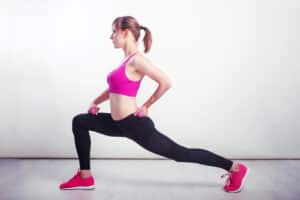 ☰ Menu
☰ Menu
Meeker is located in the heart of the White River National Forest, and local residents have access to some of the greatest snowshoeing terrain in the state. If you’re not an avid skier but want to remain active outdoors all winter long, snowshoeing provides you with a great alternative. You’ll get to soak in beautiful mountain views while getting a great cardio workout.
It’s important to understand that snowshoeing is much more challenging than a typical summer hike. Your body is weighed down by the snowshoes attached to your feet, and picking them up out of heavy snow requires considerable lower body strength. In addition, snowshoeing requires a great deal of balance, especially when traversing areas of deep snow on steep inclines. Therefore, even the most fit and experienced hikers may find that they require additional conditioning to perform at peak levels and minimize the risk of a sports injury while snowshoeing.
The following tips will help you get your body into shape for snowshoeing so that you can enjoy this exhilarating winter activity to its fullest.
For most people, cardiovascular endurance is one of the greatest challenges associated with snowshoeing. Therefore, any efforts you can make to improve your cardiovascular fitness will pay huge dividends when you get out on the snowshoe trails. Fortunately, you can easily modify your existing cardio routine to tailor it to the rigors of snowshoeing.
Walking, running, cycling and other activities that focus on leg endurance will help you prepare for the cardiovascular demands of snowshoeing. When engaging in these activities, it’s best to mimic the rigors of snowshoeing as much as possible. You can do this by adjusting the intensity, duration and incline of your regular workouts so that your body will be used to the challenges encountered when trekking through deep snow on mountain trails.
However, you’ll also need to prepare your body for the resistance you’ll experience when hiking through deep snow, as well as the additional weight of the snowshoes. Therefore, your cardio routine must help your body build added strength and power to account for this resistance. This can be accomplished by walking and running up hills – either outdoors or on a treadmill. If you’re an outdoor cyclist, cycling uphill is effective as well. If you’re riding an exercise bike, increase the resistance on the bike and ride out of the saddle regularly to mimic the movements used when snowshoeing.

Some great exercises to add to your routine to build sufficient leg strength for snowshoeing include:
Start out by performing these exercises without weights. As you begin to get stronger, add weights and gradually increase the weight used over time. This approach will help minimize your risk of an injury.
While lower body strength and conditioning is the most critical aspect of your fitness, snowshoeing still requires upper body strength to counteract the weight of the snowshoes and provide added propulsion when using poles. Therefore, your snowshoe fitness routine should include exercises to build up your upper body strength. This should include:

A great exercise to improve your balance is standing on one leg. See how long you can hold this position. As you get better, try lifting your leg higher and moving it to the side. You can also invest in a balance board for a little more challenge. Get into a crouching position and try to shift your weight on the board so that the edges don’t touch the ground.
The following exercises will help you build your core strength for snowshoeing:
Even with the most diligent fitness efforts, it’s still possible to suffer an injury while snowshoeing. At Colorado Advanced Orthopedics, we have the finest team of board-certified, fellowship trained orthopedic specialists and sports medicine doctors on the Western Slope, ensuring you receive the exceptional care necessary to recover from your injury.
In addition, you’ll benefit from our in-house physical therapy team which works closely with our orthopedics and sports medicine teams. This collaboration ensures every member of your healthcare team is aligned throughout your recovery. This results in better outcomes and allows you to return to your favorite activities as quickly as possible.
Contact us today to schedule an appointment. Colorado Advanced Orthopedics serves patients in Meeker and throughout the White River Valley.
Subscribe to our monthly publication highlighting Life's Joy and getting back to your life. We feature health tips, being out and about, and bringing joy to daily life.
Subscribe